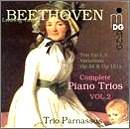The Trio Parnassus’ cycle of Beethoven Piano Trios
on Dabringhaus und Grimm is turning into something very special indeed.
Volume 1, on MDG303 1051-2 presented life-enhancing performances of
the first two trios of Op. 1; Volume 3, on MDG303 1053-2, holds the
‘Ghost’ Trio and Op. 70 No. 1.
It was a good idea to issue the C minor Trio, Op. 1
No. 3 as the sole trio on this disc. Being in Beethoven’s favourite
key, it has an inner dynamism (particularly in the outer movements)
that is not so marked in the first two trios of Op. 1. This energy is
present, latent, in the quiet opening: and how well the Trio Parnassus
projects it. Dynamic contrasts are highlighted and tension is maintained
throughout the development section. This interpretative realisation
of the core Beethovenian spirit recurs in the third movement, marked
‘Menuetto’ (but this is a long way from a courtly dance). The finale
is launched like a rocket. The Theme and Variations of the second movement
bring out the best from the Trio Parnassus. Each variation is impeccably
characterised, each shedding light on a different facet of the theme.
The recording comes into its own here: the pizzicato strings are particularly
well captured.
The couplings, two sets of variations, seem logical
in the light of this variation movement of the C minor Trio. The Fourteen
Variations in E flat, Op. 44 (c1800, published 1804) stems from
a period when the Theme and Variation form was a preferred medium for
Beethoven. The theme of this set has been identified as the Aria, Ja,
ich muss mich von ihr scheiden from Dittersdorf’s comic operetta
Das rote Käppchen oder Hilft’s nocht, so schadt’s nicht,
which received its first performance in 1788. The Trio Parnassus gives
the theme out truly staccato and detached. Once again they are responsive
to Beethoven’s shifts, from the playful to the expressive minor variation
in which Michael Gross’ cello sings so beautifully.
For the so-called ‘Kakadu’ Variations, Beethoven again
turns to comedy on the stage as his base: this time the theme is sourced
from a piece by Wenzel Müller (1767-1835) called Die Schwestern
von Prag. More specifically, he used the song ‘Ich bin der Schneider
Kakadu’ (hence the title). The set begins with a dramatic Adagio introduction.
It is clear from this how serious Beethoven is about this form (just
think how it blossomed in the late pieces, notably the great Diabelli
Variations), and so it turns out. Once again the cellist may be
singled out for special mention, but one should also point to the tightness
of ensemble (particularly in the Tenth and final Variation, marked ‘presto’).
A disc that will bring much pleasure, then. One can
revel in the creation of true chamber music by a most talented young
trio.
Colin Clarke


